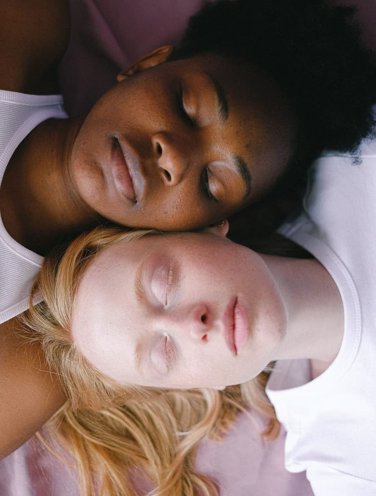Skincare For Blemish-Prone Skin - An Expert Guide

The pursuit of perfect, flawless skin is something modern men and women covet. However, as humans, porcelain skin is not quite an achievable feat unless you live through camera filters only. In reality, blemishes, blackheads, breakouts, pores, bumps, veins, lines, pigmentation, scars and a whole host of other marks make us human, not robots with perfectly latex-esq skin.
According to
We spoke to leading skincare experts to demystify blemish-prone skin and explain how to treat it from all possible angles. Here’s how to boost your skin’s confidence; let’s begin.
What is blemish-prone skin?
Blemishes are a common skin concern which will affect all of us at some point, regardless of age.
Blemish-prone skin is a collective term referred to as any imperfection or flaw you see on the skin’s surface. It can be a spot, bump, discolouration, or mark on the face.

What are the common types of blemishes and what causes them?
“The cause of blemish-prone skin will always be a combination of excess sebum and bacteria. What causes excess sebum can be hormonal, medication, or genetics.
What causes the bacteria will differ as well. Sometimes, it’s triggered by daily pollution and incorrect use of daily products, among others,” explains Charlotte McHale, Clarins Training Manager.
1. Acne
What’s the difference between acne and blemishes? Acne is a type of blemish on the skin. It is a common skin condition when pores become clogged with oil, dirt, and dead skin cells. The causes are quite varied and brought about by a series of factors, from hormonal imbalance, genes, and diet to lack of sleep, improper skincare routine and stress.
The ‘acne’ category comprises pesky blackheads, whiteheads, papules (mild tiny red dots known as pimples), pustules (pimples with pus), nodules and cysts.
2. Hyperpigmentation
Another type of blemish is hyperpigmentation.
Hyperpigmentation is any area of your skin that is darker than the rest. Like acne, it is a harmless skin condition.
It can appear as a post-acne scar called ‘post-inflammatory hyperpigmentation’ or dark patches on the skin caused by hormonal imbalance amongst pregnant women called ‘melasma.’
There are multiple known causes for triggering hyperpigmentation, such as sun exposure, pollution, irritation from skincare products, the ageing process, inflammation on the skin, and allergic drug reaction to other rare medical conditions.
The ‘hyperpigmentation’ category includes age spots (ageing and accumulated sun exposure) and sunspots (extreme and unprotected sun exposure).
3. Hives
Hives are another type of blemish we all encounter due to an allergic or skin reaction. It is a skin rash that appears red, swollen, painful or itchy.
Experts say allergies are thought to be the primary cause of hives. It can occur a few minutes after you eat or drink something you’re allergic to or triggered by something in the environment or a reaction from a skincare ingredient. If you have an allergic reaction to any product, stop using it immediately and consult a doctor or dermatologist.
How to skincare for blemish-prone skin?
Understanding the common types and causes of blemishes will narrow your treatment plan. Here’s the best skincare for blemish-prone skin, according to the experts.
If you are treating acne-blemished skin, chances are you have an oily or combination skin type.
Dr
She recommends using
McHale advises using a cleanser that is formulated for your skin type.
“Don’t assume your skin type is oily just because you have blemishes. You can still get them even if you have dry skin. It might just be hormonal. Book with a professional and cleanse according to your skin type.”
If you are treating a type of hyperpigmentation
Post-acne marks or sun-induced spots
Applying
Age spots
Related to ageing, sun exposure and/or hormonal drop. Specific plant and fruit extract are known to reduce the appearance of age spots and can be found in the Clarins’ 60 and up Nutri-Lumière Range. Applying
If you suffer from hives
Hive rashes usually settle down within a few minutes to a few days. However, the best way to prevent them from ever occurring again is to keep track of triggers with a journal. You can also try products from the
The key ingredient in our products, Clary Sage extract, is proven to harmonise with the skin as it allows it to be instantly soothed and protected, increasing the skin’s tolerance.
We recommend the
Blemish-Prone ‘Beauty Cupboard Saviour’
Making sure you are stocked with certain skincare staples will help ward off blemishes and keep them at bay.
Cleansers
A calming and gentle cleanser is vital for the beginning of a skincare routine for blemish-prone skin. One of the best cleansers for blemish-prone skin is
Moisturiser
Regardless of your skin type, applying moisturiser is necessary. Dr Gao says: “It’s a myth that oily skin does not need a moisturiser. A good moisturiser keeps the skin barrier healthy and prevents breakouts even if you have oily skin.”
Apart from helping your skin barrier seal in moisture, moisturisers are also formulated to address specific skin issues, such as helping regulate your overall sebum production, reduce the appearance of hyperpigmentation, and soothe sensations of skin discomfort. Pick the one your skin needs.
The best moisturiser for blemish-prone skin we recommend is
Spot treatment
“It’s helpful to use products with anti-inflammatory ingredients such as salicylic acid in
These ingredients reduce redness and blemishes and improve the appearance of pores. “Apply this to areas prone to blemishes. However, these products can cause dryness and irritation, so they should be used with moisturiser. It can be used a few times a week or daily if tolerated,” she advises.
Plant-based Retinols
We swear by nature’s retinol, organic harungana, a plant-based active ingredient, which has been shown to work 40% more effectively than the far better-known retinol. Find it in the
Facial Clay Mask
“You can help reduce inflammation and swelling by using
